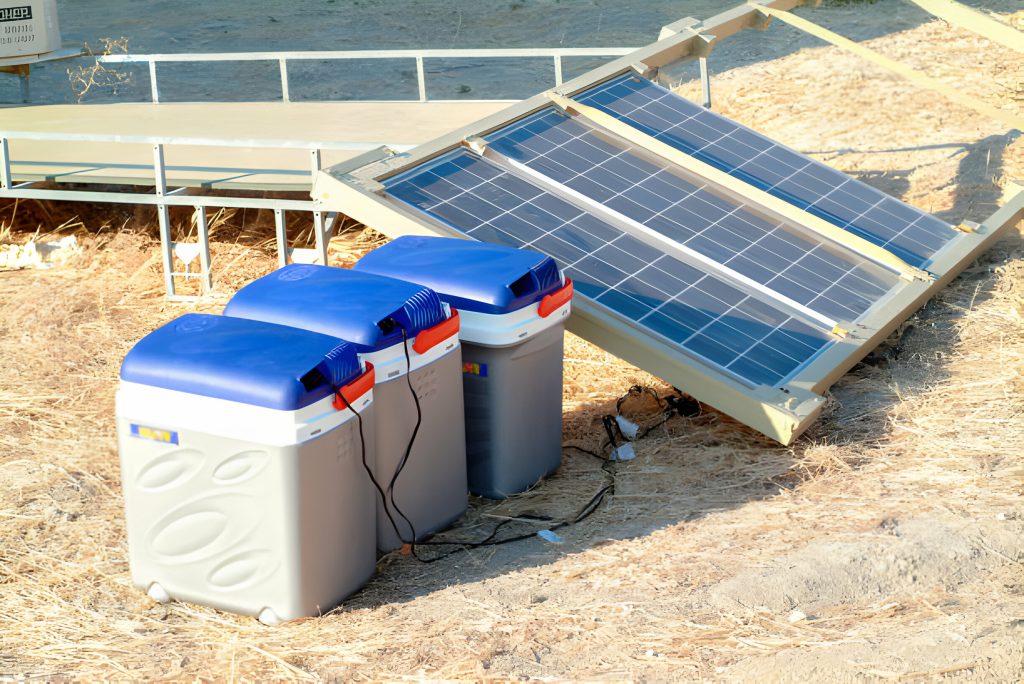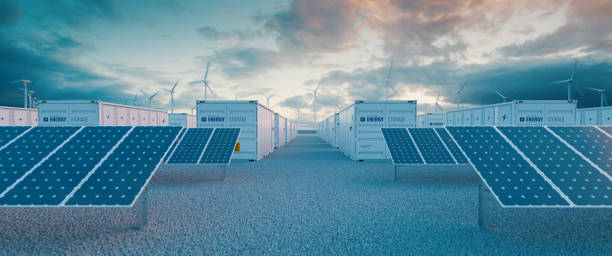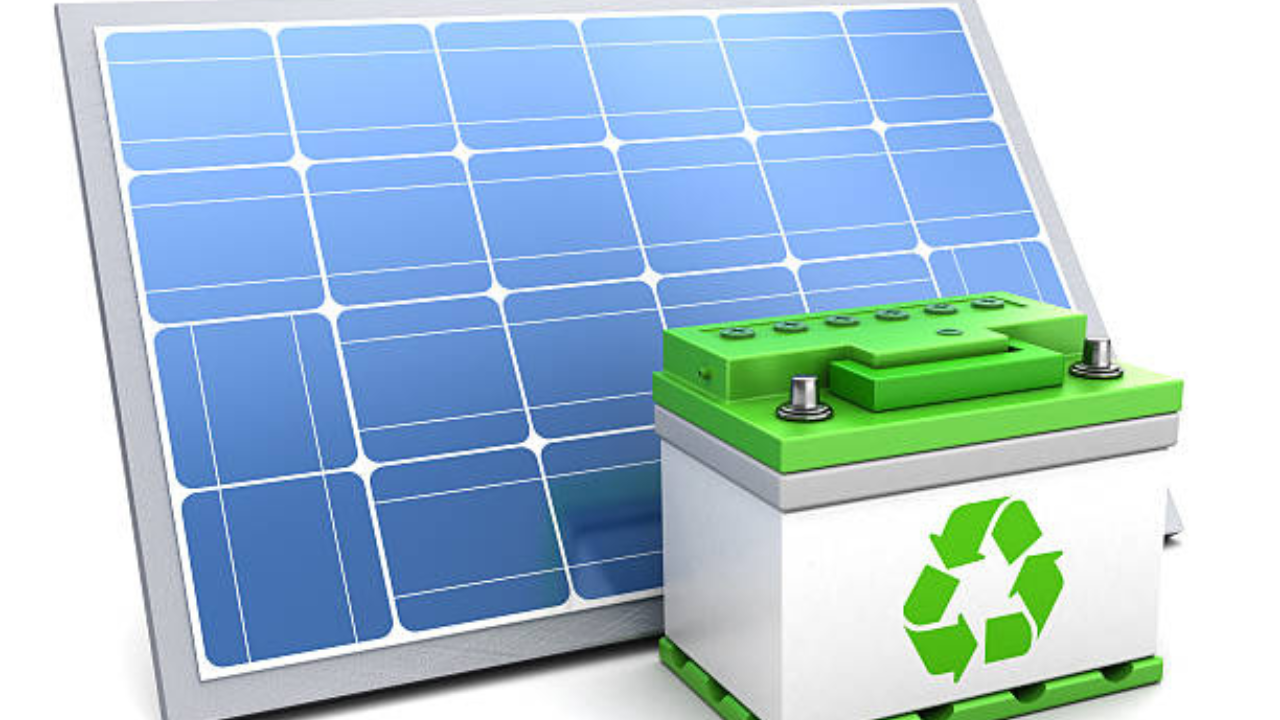When solar power batteries are full, excess energy can be returned to the grid or stored for later use. This helps to maximize the efficiency and sustainability of the solar power system.
Solar power systems are an increasingly popular choice for sustainable energy generation. Solar power and battery storage have become inexorably linked as the demand for renewable energy solutions grows.
We will explore what happens to solar power when batteries are full and how this impacts solar energy systems’ overall efficiency and effectiveness.
Understanding this process is crucial for maximizing the benefits of solar power and contributing to a more sustainable future. So, let’s delve into solar power and battery storage dynamics when the batteries reach total capacity.
The Role Of Batteries In Solar Power Systems
Solar power has become an increasingly popular and reliable source of renewable energy. The Role of Batteries in Solar Power Systems is essential as they are crucial in storing and distributing excess energy.
This ensures continuous power supply, even when the sun is not shining. Let’s delve deeper into how batteries store excess solar power and why battery storage is essential for solar power systems.
How Batteries Store Excess Solar Power
Batteries store excess solar power through a process called charging. During periods of high solar energy production, such as during sunny days, the excess energy generated by the solar panels is converted and stored in the batteries for later use.
This stored energy can then be utilized during periods of low solar energy production, such as at night or during cloudy days, allowing for a consistent and reliable power supply regardless of external conditions.
Why Battery Storage Is Essential For Solar Power Systems
- Battery storage is essential for solar power systems as it enables energy independence, allowing homeowners and businesses to rely less on the traditional grid and reducing their overall energy costs.
- Batteries also provide a reliable backup power source, ensuring continuous electricity supply during power outages or emergencies.
- Using battery storage in solar power systems increases energy efficiency by optimizing the use of renewable energy and reducing wastage.
- By storing excess solar power, batteries contribute to a more stable and sustainable energy grid, reducing reliance on non-renewable energy sources and lowering carbon emissions.

The Impact Of Full Batteries On Solar Power
The Impact of Full Batteries on Solar Power
Limitations Of Solar Power Generation
Solar power generation is subject to several limitations. Weather patterns, daylight hours, and geographical location can affect the amount of energy solar panels produce.
Moreover, the efficiency of solar panels decreases over time due to factors like dirt accumulation and wear and tear.
Excess Solar Power And Battery Capacity
When solar panels produce more energy than the household or facility requires, the surplus energy can be stored in batteries. However, once the batteries are full, there is no more capacity to store the excess energy, leading to potential wastage.
Managing Solar Power Surplus
Effective management strategies are essential to prevent the waste of excess solar power. This may involve diverting excess energy to other applications, such as heating systems or electric vehicle charging stations. Additionally, grid-tie systems allow surplus energy to feed back into the grid, providing credits or compensation from the utility company.
Maximizing Efficiency With Battery Management
Discover how to maximize efficiency with battery management in solar power systems. Learn what happens when batteries reach their total capacity and how to optimize energy usage for sustainable results.
Optimizing Battery Charging And Discharging
When it comes to maximizing the efficiency of solar power systems, proper management of the batteries plays a crucial role. One important aspect of battery management is optimizing the charging and discharging process.
By carefully controlling these two phases, you can ensure that your solar power system operates at its peak performance, saving energy and extending the life of your batteries.
Charging the batteries efficiently is essential to maximize their capacity and energy storage capabilities. This involves monitoring the state of charge (SOC) and the charging current to prevent overcharging, which can reduce battery lifespan.
By implementing intelligent charging algorithms and utilizing technologies such as pulse charging, you can deliver the optimal charging current for your batteries. Additionally, considering factors like temperature compensation and voltage thresholds helps maintain the battery’s health and performance.
Optimally discharging the batteries is equally essential to maximize efficiency. Avoiding excessive discharge rates can prevent battery cell damage and maximize lifespan.
Implementing a battery management system (BMS) that constantly monitors the state of the batteries and controls the discharge current can help regulate the energy output. This ensures a steady and controlled discharge, which not only helps maximize the battery life and preventing unnecessary energy wastage.
Balancing Energy Supply And Demand
In addition to optimizing battery charging and discharging, battery management also plays a crucial role in balancing energy supply and demand. In a solar power system, the energy generated from the sunlight must be efficiently stored in the batteries for later use, especially when there is insufficient sunlight or during peak demand periods. To achieve this balance, a sophisticated battery management system is required.
A battery management system capable of monitoring and predicting energy demand can help optimize energy storage and distribution. The system can determine optimal charging and discharging rates by analyzing historical data and real-time energy consumption patterns. This ensures that the batteries are neither overcharged nor underutilized, resulting in maximum energy efficiency throughout the day.
Integrating Smart Grid Technologies
Integrating innovative grid technologies is essential to enhance the efficiency of solar power systems further. A smart grid enables seamless communication and coordination between the solar power system, batteries, and the larger electrical grid. This integration allows for more efficient energy management, optimizing the solar power system’s performance and overall grid stability.
With the help of innovative grid technologies, solar power systems can dynamically adjust their energy generation, storage, and consumption based on real-time grid conditions. This enables the system to respond to changes in supply and demand, ensuring that excess solar energy is not wasted and that the grid is always balanced.
By enabling bidirectional energy flow, smart grid technologies also allow solar power systems to interface with the grid, selling excess energy back to the utilities, thus further enhancing the system’s overall efficiency.

The Future Of Battery Technology For Solar Power
As batteries in solar power systems reach total capacity, surplus energy is stored for later use, ensuring continuous power supply during peak demands or when sunlight is insufficient. The advancements in battery technology hold promise for enhanced energy storage, offering greater sustainability and reliability for solar power solutions.
Advancements In Battery Storage
Regarding the future of battery technology for solar power, one of the most exciting developments is the advancements in battery storage. These advancements address what happens to solar power when batteries are full.
One essential advancement is the improvement in battery capacity. Manufacturers are constantly working to increase the amount of energy batteries can store. This means that even when the batteries are complete, they can hold more excess solar power.
Another development is the enhancement of battery efficiency. Manufacturers are finding ways to make batteries more efficient in storing and releasing energy. This means that even when batteries are complete, they can effectively handle the surplus solar power by storing it more efficiently or releasing it back to the grid.
Enhancing Durability And Lifespan
To maximize the effectiveness of battery storage for solar power, there is also a focus on enhancing the durability and lifespan of batteries. This is crucial to ensure that batteries can withstand the demands of long-term use and provide reliable performance over an extended period.
Manufacturers are exploring different materials and designs to improve the durability of batteries. This includes using materials that can withstand extreme temperatures and harsh environments, preventing battery performance degradation.
In addition, efforts are being made to prolong battery lifespan. By implementing advanced battery management systems, manufacturers can monitor and optimize battery usage, which helps to extend their overall lifespan. This means that batteries can handle the surplus solar power more efficiently before needing replacement.
Potential Solutions For Solar Power Surplus
The surplus of solar power when batteries are full presents a unique challenge. However, researchers and engineers are working on potential solutions to deal with this issue effectively.
One solution is the integration of smart grid technology. By incorporating intelligent grid systems, excess solar power can be fed back into the grid, reducing wastage and maximizing the utilization of renewable energy resources.
Another potential solution is the implementation of power-to-gas technology. This involves converting excess solar power into hydrogen or other gases stored for later use. These gases can be used as fuel for various applications, including heating and transportation, efficiently utilizing surplus solar power.
Overall, the future of battery technology for solar power looks promising. With advancements in battery storage, enhancement of durability and lifespan, and potential solutions for surplus solar power, we can expect more efficient and sustainable use of solar energy.
Case Studies: Real-world Examples
Examining real-world examples offers valuable insights into successfully integrating batteries and solar power. These case studies showcase how organizations have harnessed the power of solar energy and efficiently managed surplus electricity when batteries reach total capacity.
We can understand the lessons learned and identify best practices for optimizing solar power systems by analyzing these examples.
Successful Integration Of Batteries And Solar Power
Several organizations have successfully integrated batteries with their solar power systems, effectively managing excess energy and ensuring no waste. These success stories demonstrate the potential of combining solar power with battery storage to create sustainable and efficient energy solutions.
One example is ABC Corporation, a large manufacturing company that installed solar power and battery storage systems. By adding battery storage, ABC Corporation could capture and store excess energy generated during the day.
This stored energy was utilized during periods of high demand or when the solar panels weren’t producing enough power. This integration significantly reduced their reliance on the grid, resulting in substantial cost savings and environmental benefits.
Another notable success story is XYZ School, which implemented a solar power system and battery storage. The school’s energy demand peaked during the daytime while students were present. By incorporating battery storage, the excess energy generated during the day was stored and used to meet the evening energy requirements, including after-school activities and facility maintenance.
This implementation leveled out the school’s energy consumption and reduced their electricity bills, allowing them to allocate more funds to educational programs.
Lessons Learned And Best Practices
Examining these real-world case studies provides us with important lessons learned and best practices for the successful integration of batteries and solar power:
- Proper capacity sizing: Ensuring that the battery storage capacity aligns with the energy demands throughout the day is crucial for optimal utilization of solar power.
- Innovative energy management: Implementing intelligent energy management systems, such as automated charging and discharging algorithms, can maximize the efficiency of battery storage systems.
- Regular maintenance: Conducting routine maintenance checks and ensuring proper ventilation and temperature control of battery storage systems can extend their lifespan and optimize performance.
- Monitoring and analysis: Continuously monitoring and analyzing the energy production and consumption patterns helps identify opportunities for further optimization and potential areas of improvement.
- Knowledge sharing: Regularly sharing experiences and knowledge among organizations implementing similar systems can foster collaboration and facilitate the exchange of best practices.
By implementing these lessons learned and best practices, organizations can effectively harness the potential of solar power and batteries, optimizing their energy systems while minimizing waste and reducing carbon footprint.
What happens to solar panels with no load
When a solar panel is not connected to any load or is not supplying power to any device, it is essentially in an open-circuit condition. In this situation, several things can occur:
-
Voltage Output: The voltage across the terminals of the solar panel will be at its open-circuit voltage (VOC). This is the maximum voltage the solar panel can produce under no-load conditions.
-
Current Output: The current flowing through the circuit will be minimal since there is no load drawing power. This current is often called the short-circuit current (Isc), the maximum current a solar panel can produce.
-
No Power Production: Although voltage potential exists, no power is delivered to a load because no load is connected to consume the electricity.
-
Energy Wasted: Solar panels may still receive sunlight and convert it into electrical energy, but without a load, it is not utilized or delivered anywhere.
-
No Net Power Consumption: Since there’s no load, the solar panel is not drawing any power from the sun, but it’s also not delivering any power to a practical application. The solar panel essentially operates at its open-circuit conditions, with the generated power not being utilized.
It’s important to note that solar panels are designed to work optimally when connected to a load, allowing them to operate at a point on their current-voltage curve that maximizes power output. In practical applications, solar panels are connected to charge batteries, power electrical devices, or feed electricity into the grid to ensure efficient utilization of the generated solar power.
What happens to excess solar power generated off-grid
In off-grid solar power systems, excess solar power generated refers to the situation where the solar panels produce more electricity than is currently consumed or stored. Several options exist for handling excess solar power in off-grid setups:
-
Battery Storage: Off-grid systems typically include batteries to store excess solar power generated during periods of high sunlight. These batteries store the energy for later use when lower solar production or demand exceeds current generation. Properly sized battery banks can help balance energy production and consumption in off-grid systems.
-
Dump Load or Diversion Load: In some off-grid systems, a dump or diversion load is used when the batteries are fully charged and there’s excess solar power. This load is essentially a resistive element or another device that consumes the excess electricity to prevent overcharging of the batteries. Common examples include electric water heaters, space heaters, or other resistive loads.
-
Charge Controller Settings: Charge controllers in off-grid solar systems play a crucial role in managing the flow of electricity between the solar panels and the batteries. Some charge controllers allow you to set voltage thresholds at which excess power is diverted to a load or used in another way.
-
Backup Generator: In certain situations, an off-grid system may incorporate a backup generator. When solar production is insufficient or during prolonged periods of low sunlight, the generator can provide power and recharge the batteries. Excess solar power can be used to reduce the generator’s runtime.
-
Hybrid Systems: Some off-grid systems are designed to be hybrid, incorporating other renewable energy sources such as wind or hydro. This diversification helps balance energy production and consumption, reducing reliance solely on solar power.
Efficient management of excess solar power is crucial in off-grid systems to ensure the reliability and sustainability of the power supply. Careful planning and system design are necessary to match energy production with demand while minimizing energy waste.
How to keep a solar panel from overcharging a battery
Preventing overcharging batteries in a solar power system is crucial for the safety and longevity of the batteries. Here are several methods to ensure that a solar panel does not overcharge a battery:
-
Charge Controller:
- Install a solar charge controller between the solar panel and the battery. A charge controller regulates the voltage and current from the solar panel to prevent overcharging. It monitors the battery’s state of charge and adjusts the charging process accordingly.
-
MPPT (Maximum Power Point Tracking) Charge Controllers:
- MPPT charge controllers are more advanced than PWM (Pulse Width Modulation) controllers and can optimize the power output from the solar panel. They are better at adjusting to varying light conditions and can help prevent overcharging by efficiently converting excess power into usable energy.
-
Set Charge Controller Parameters:
- Configure the charge controller settings according to the specifications of your battery. Most charge controllers allow you to set voltage and current limits. Ensure these settings match the requirements of your specific battery type.
-
Temperature Compensation:
- Some charge controllers offer temperature compensation features. This adjusts the charging parameters based on the temperature of the batteries, helping to optimize charging and prevent overcharging in varying temperature conditions.
-
Properly Size the Solar Panel and Battery:
- Ensure the solar panel and battery bank are appropriately sized for your energy needs. Oversized solar panels can lead to overcharging compared to the battery bank size. A properly matched system will generate enough power to meet your needs without causing overcharging issues.
-
Use Deep-Cycle Batteries:
- Choose deep-cycle batteries designed for solar applications. These batteries are designed to withstand the cycling and charging patterns typical in solar power systems. They are less prone to damage from overcharging compared to automotive batteries.
-
Automatic Load Control:
- When the batteries are fully charged, some charge controllers have load control features that automatically divert excess energy to a secondary load, such as a water heater or other resistive loads. This helps prevent overcharging by utilizing excess energy.
-
Regular Maintenance:
- Periodically check the system for proper functioning and inspect the battery bank. Maintain clean and well-connected components to ensure the system operates efficiently.
By implementing these measures, you can help ensure that your solar panel system operates safely and effectively without overcharging the batteries, extending their lifespan and optimizing the overall performance of the solar power system.

Frequently Asked Questions Of What Happens To Solar Power When Batteries Are Full
What Happens When Solar Power Batteries Are Full?
When solar power batteries are complete, the excess energy generated by the solar panels is either fed back into the grid or stored in the batteries for later use. This ensures that no energy goes to waste and gives you a continuous power supply even when the sun is not shining.
What happens to excess solar power when batteries are entirely off-grid?
When off-grid solar batteries are full, excess solar power is typically diverted to dump loads (such as heating elements) or, in some cases, to the grid (if connected) or other energy-consuming devices to prevent overcharging and waste.
Do batteries stop charging when solar gets full?
Yes, batteries typically stop charging when solar panels generate enough power to meet the battery’s capacity or when a charge controller determines the batteries are fully charged to prevent overcharging.
What does a solar charge controller do when the battery is full?
A solar charge controller regulates the charging process and prevents overcharging when the battery is full by reducing or completely stopping the flow of electricity from the solar panels to the battery.
What happens to excess solar power?
Excess solar power is stored in batteries, diverted to dump loads, fed back to the grid (if connected), or otherwise managed to prevent overcharging and optimize energy use in the system.
How long do batteries last for off grid solar system?
The lifespan of batteries in an off-grid solar system typically ranges from 5 to 15 years, depending on factors like battery type, quality, usage patterns, and maintenance.
What is the drawback of off-grid system in solar electric power?
The main drawback of off-grid solar power systems is the need for battery energy storage, which adds cost and requires maintenance. Additionally, off-grid systems may face challenges meeting power demands during extended periods of low sunlight.
What is the drawback of off-grid solar system?
The main drawback of off-grid solar systems is the need for battery energy storage, which adds cost and requires maintenance. Additionally, these systems may face challenges in meeting power demands during extended periods of low sunlight.
What happens if you produce more electricity than you use?
If you produce more electricity than you use, the excess electricity can be stored in batteries, fed back to the grid (if connected), or diverted to other loads. You may sometimes receive compensation for the surplus energy through net metering or other arrangements.
Conclusion
When solar power batteries are complete, the excess energy generated by the solar panels can be transferred back to the grid or stored for later use. This ensures that no energy goes to waste and maximizes the efficiency of solar power systems.
With the advancement in battery technology, the future looks promising for integrating solar power into our daily lives, providing a sustainable and renewable energy solution.

I am a technology Specialized . I have experience in Technology, and all types of electronic devices like Battery . So I work on solving these issues and give various tips on these issues
